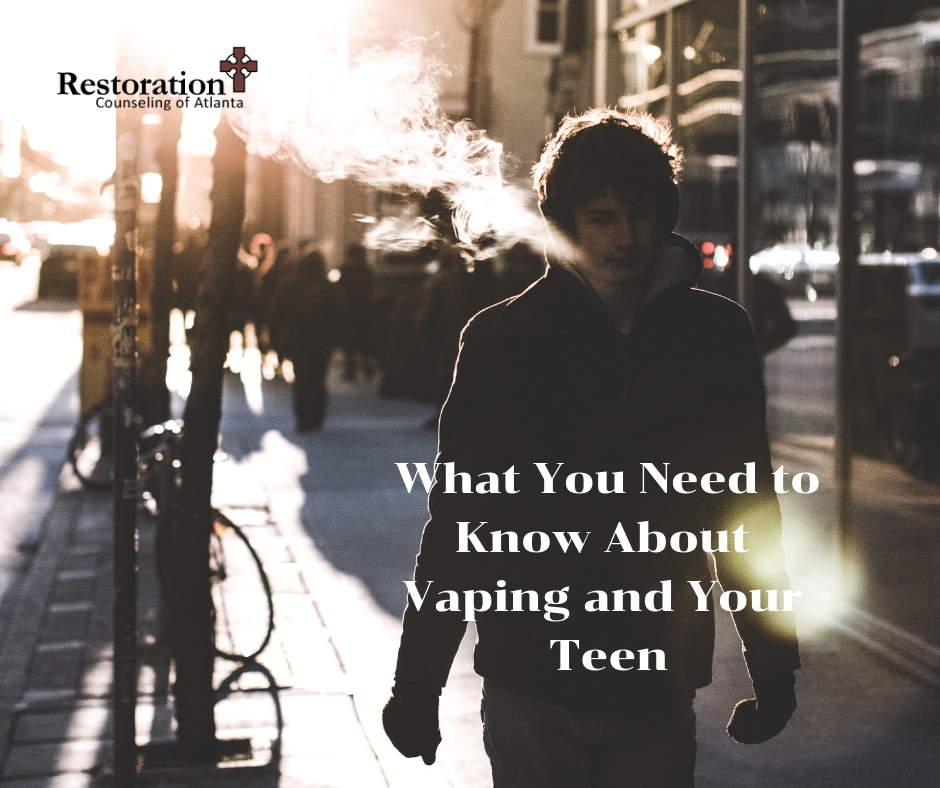I remember the alarm I felt the first time I saw someone vaping. There was an extremely large cloud coming out of the driver’s side window, and I thought the car was surely on fire. My teenage daughter giggled and informed me that it was just someone vaping. “Vaping? What is that?”
What is Vaping?
Vaping (i.e. the modern term for using e-cigarettes) is different from traditional cigarettes in that it relies on electricity rather than combustion. Instead of burning tobacco and other materials to create smoke, e-cigarettes have a battery that heats liquid into vapor (hence “vaping”). There are “vape pens,” which are cylindrical, but can be larger than cigarettes and come in different colors. There are also vape mods (short for “modified”), which are box-shaped devices that are also larger than the typical cigarette. Most vaping devices now have a longer battery life, hold more liquid, offer more customization, and provide a more enjoyable experience than their predecessors. For example, vapers can purchase e-juice in an extensive variety of flavors and can choose what amount of nicotine they want in their e-liquid.
What is in e-cigarette liquids?
Many take up e-cigs as an alternative to smoking traditional cigarettes because it is viewed as safer due to containing less carcinogenic substances and less addictive. While it is possible to vape nicotine-free e-liquid, most e-cigarettes do contain nicotine, the same addictive substance that is in traditional cigarettes. In fact, e-liquids/e-juices that can be vaped can contain any number of things. Marijuana (or just THC, the mind-altering substance in marijuana) can be vaped in the form of hash oils or even from the dried plant leaves. Because of the nature of vaping, it doesn’t produce the same scent as marijuana is smoked, therefore allowing a user to go undetected. This makes vaping the substance more popular among teens.
Beyond that, a quick search of the internet yields many lists for different substances that can be vaped. This list includes nutmeg, Salvia Divinorum (a plant with psychogenic properties that produces hallucinations), and other illicit drugs like bath salts. Many users are willing to experiment with different liquids in their devices, which can be extremely dangerous to one’s health and is not recommended, though teens may not realize the dangers and are more willing to experiment.
Are teens really vaping?
According to the CDC, e-cigarettes are now the most commonly used tobacco product among youth.
- In the United States, youth are more likely than adults to use e-cigarettes.
- In 2016, 3.2% of U.S. adults were current e-cigarette users, while more than 2 million U.S. middle and high school students used e-cigarettes in the past 30 days, including 4.3% of middle school students and 11.3% of high school students.
- Monitoring the Future, a national survey of 8th, 10th, and 12th graders conducted each year since 1975, recently found that 1 out of 3 high school seniors has tried vaping in the last year, while 1 out of 6 seniors vaped in the last month. Roughly 11% reported having vaped hash oils (i.e. marijuana).
The sale of nicotine and e-cigarette supplies to minors is illegal in the U.S., but resourceful teens are shopping for these online at sites like e-Bay that do not have age verification measures or having an of-age friend buy for them.
Why is vaping so popular?
-
- Brands are being marketed to target younger users. The FDA found that “in 2013-2014, 81% of current youth e-cigarette users cited the availability of appealing flavors as the primary reason for use.” The liquids come in a wide variety of flavors, many of the sweetest such as Candy Crash, Sour Sweet, and Kiwi Apple Strawberry, are appealing to younger users.
- People see vaping as a safer alternative to smoking—and it might be. Several studies have shown that the number of toxins in vaping is likely less than in traditional cigarettes and the amount of nicotine finding its way into the bloodstream from vaping an e-cigarette is less than what you would expect from smoking a conventional cigarette with comparable nicotine content. However, researchers also point out that the evidence is not conclusive and that further studies in this area are needed.
- JUUL is now considered mainstream. One type of e-cigarette device that is especially popular among students is the JUUL, a slim and sleek device that resembles a flash drive. JUUL is only about two years old, but the company has been having difficulty producing enough supplies to keep up with demand, despite producing 20 million products monthly. Likely reasons why JUULing is increasing in popularity among students are that its design makes it easy to hide from parents and school personnel, because the vapor doesn’t leave the odor that regular cigarettes do so it’s not as detectable, and there is a perception that JUULing is safer than smoking regular cigarettes. It is important to note that the amount of nicotine in each JUULpod is significant: one JUULpod is 0.7 ml, and its nicotine content is 59 mg/ml per pod. This is equivalent to the amount of nicotine in a wholepack of cigarettes. The result is that the most popular method for vaping among younger people also happens to be the way to vape the largest amount of nicotine at one time.
- The Cool Factor— Part of the appeal of regular cigarettes has always been that some think they look cool, and the same is true of vaping. For example Austin Lawrence, the so-called “Vape God,” took up vaping in order to get over his addiction to cigarettes. He has since become an expert at manipulating vapor into a variety of spectacular shapes, which impresses audiences on YouTube and Instagram.
What is controversial about vaping?
Unlike cigarettes, vaping has not been extensively researched and studied. In fact, the FDA is still trying to figure out how to classify and regulate electronic smoking. Because of the lack of definitive research, e-cigarettes have both their passionate followers and critics. Proponents believe that vaping is a better alternative to smoking regular cigarettes with all the toxic chemicals in them. They say that it is an effective smoking cessation aid for those wanting to quit. On the other side of the argument is the point that, while it might be better for you than traditional smoking, it is still not good for you due to the nicotine content and the risk of addiction.
Also, little is known about the other chemicals present in e-liquids and the potential harm these could do to users. Most companies don’t list every single ingredient in their e-juices. There is evidence that some of these chemicals, such as diacetyl, can be harmful to users, as well as to those exposed to the vapor second-hand. Additionally, while there is evidence that suggests e-cigarettes help people stop smoking, there is also evidence that e-cigarettes increase the likelihood that non-smokers will start smoking combustible cigarettes after vaping. Finally, perhaps the most controversial arguments surround the use of e-cigarettes by minors.
One reason for concern is that teens have greater health risks than adult users because nicotine exposure can harm adolescent brain development, which continues into the early to mid-20’s. E-cigarette aerosol can contain chemicals that are harmful to the lungs. It is also illegal for minors to consume nicotine, yet many current marketing methods target this young population, which increases the chances of unhealthy and unwise life choices for these youth.
There is action being taken to control teen use. In November 2018, the U.S. Food and Drug Administration (FDA) announced its plans to ban the sale of flavored e-cigarettes, including Juuls. The FDA’s decision will be based on whether or not several e-cigarette manufacturers can prove that they are capable of keeping their products away from minors.
Wouldn’t I know if my child were vaping?
There are plenty of websites and YouTube videos that offer tips and tricks for concealing one’s habit, often referred to as “stealth vaping.” These include different inhalation techniques for minimizing vapor, less conspicuous devices to purchase, e-liquids that have less obvious scents, and how-to guides for concealing devices in cups or bottles. The bottom line is that if teens want to get away with vaping, they can and will, thanks to the Internet and current lack of regulations to keep minors from purchasing the products. The best thing we can do is educate ourselves, be alert, and never stop reminding our children that we want the absolute best for them long-term, not just to keep them from having fun in the moment.
How can I keep my child from vaping?
There are a number of steps you can take as a parent to help your children avoid vaping.
- Educate yourself by reading about vaping. There’s a guide from the Surgeon General that includes tips for talking to your kids about e-cigarettes. https://e-cigarettes.surgeongeneral.gov/takeaction.html
- Don’t assume anything. Be open to the idea that your children might currently be vaping without your knowledge or that they might be interested in doing so in the future. Be on the look out for ways your children might be concealing a vaping habit. Even if your children are not using e-cigarettes, it is still a good idea to talk to them about the issue to educate them about it. Vaping is popular among younger people, and there is a lot of misinformation floating around.
- Pursue relationships with your kids. Ideally, a conversation with your children about vaping should take place within the broader context of your relationships with them. If you are pursuing and getting to know your kids, you’ll be aware of their desires and struggles and have a greater likelihood of knowing whether or not they’d be prone to try vaping out.
- React out of love, not condemnation. If you suspect or discover that your underage (or of age) children are vaping, it is crucial that you do not react out of anger or condemnation. Focus on understanding why they are vaping and/or why they hid their actions from you. The issue is not merely that they broke a rule; it is that by doing so, they are risking their health and setting themselves on a path to addiction. One day, your kids will be able to consume nicotine legally, so it is essential that you communicate your concern about vaping because you love them and because you don’t want them or others to be hurt in any way.
Here are some questions you might raise when you talk with your children:
- What do you know about vaping? Do your friends vape, and if so, why? Have you ever been interested?
- Why, in general, do you think people like to vape? Why do some people vape nicotine-free e-liquids? Do you think they have good or valid reasons for doing so?
- How often do you think we make decisions about our habits based on how those habits will affect those around us? Is it practical to expect people to do that with all their habits?
- Why do some people vape even though doing so is illegal? What does this say about their view of authority?
- What are characteristics of someone who has a habit of self-control? Consider any area of life—time, money, relationships, food, etc. What do you observe about people who don’t live with self-control?
- Do you think there is a valid place for vaping if someone is using it to stop an addiction to regular cigarettes? Why or why not?
- How can we have wisdom with what we put into our bodies? Discuss what this might look like when it comes to the food we eat or even the amount of caffeine we consume.
Written by: Paige Santmyer, MA LAPC
paige@restorationcounselingatl.com x 157
Roswell Location Only
 Paige completed her undergraduate work at the University of Virginia, earning her BA in Psychology. She is committed to providing a safe and comfortable atmosphere, where clients can explore the challenges they are facing. She also believes in addressing the individual’s entire person hood, assessing needs in all domains of life instead of focusing solely on mental health needs. Paige works with adults and teens around issues of depression, anxiety, mood disorders, relationship issues, trauma, PTSD, and life transitions.
Paige completed her undergraduate work at the University of Virginia, earning her BA in Psychology. She is committed to providing a safe and comfortable atmosphere, where clients can explore the challenges they are facing. She also believes in addressing the individual’s entire person hood, assessing needs in all domains of life instead of focusing solely on mental health needs. Paige works with adults and teens around issues of depression, anxiety, mood disorders, relationship issues, trauma, PTSD, and life transitions.
Resources for more information
- 2016 Surgeon General’s Report: E-Cigarette Use among Youth and Young Adults https://www.cdc.gov/tobacco/data_statistics/sgr/e-cigarettes/index.htm?s_cid=bb-osh-sgr2016-002
- What are “ENDS” (electronic nicotine delivery systems)? (A resource for physicians, but contains helpful info) https://www.aap.org/en-us/Documents/5AsENDSfactsheet.pdf
- “Quick Facts about ENDS” (from the American Academy of Pediatrics) https://www.aap.org/en-us/advocacy-and-policy/aap-health-initiatives/Richmond-Center/Pages/Electronic-Nicotine-Delivery-Systems.aspx
- “E-cigarette use triples among middle and high school students in just one year” (CDC report) https://www.cdc.gov/media/releases/2015/p0416-E-cigarette-use.html
- “Vaping: How E-cigs Work (Infographic)” https://www.livescience.com/41211-how-electronic-cigarettes-work-infographic.html
- “E-Cigarettes: What Vaping Does to Your Body” https://www.livescience.com/54754-what-e-cigarettes-do-in-your-body.html
- “E-Cigarette Vapor—Even when Nicotine-Free—Found to Damage Lung Cells” http://www.the-aps.org/mm/hp/Audiences/Public-Press/2015/25.html
- “E-Cigarettes May Lure Teens into Traditional Smoking” https://www.livescience.com/49130-e-cigarettes-lure-teens-smoking.html
- “Electronic Cigarette Sales to Minors via the Internet” (scholarly article that looks at how easily e-cigs and vaping devices can be acquired by minors) https://jamanetwork.com/journals/jamapediatrics/fullarticle/2174572
- “Vaping Regulations, State by State” (warning: from vapes.com, which sells vaping products and gives notifications when people purchase something from their site, but is regularly updated with accurate info about vaping regulations) https://www.vapes.com/pages/vaping-regulations-state-by-state
- “What is Vaping? Learn the Basics and the Secrets” (warning: from vapingdaily.com, which is pro-vaping, but offers helpful material that any teen with access to the internet can easily find) https://vapingdaily.com/what-is-vaping/
References
Axis.org. (2018). Parent’s Guide to Vaping. Retrieved from: https://axis.org/wp-content/uploads/2018/03/Axis-Parents-Guide-to-Vaping.pdf?_ga=2.117665417.10433634.1543260649-1309975336.1543260649
Center for Disease Control and Prevention. (2018). Quick Facts on the Risks of E-cigarettes for Kids, Teens, and Young Adults. Retrieved from: https://www.cdc.gov/tobacco/basic_information/e-cigarettes/Quick-Facts-on-the-Risks-of-E-cigarettes-for-Kids-Teens-and-Young-Adults.html
Center for Disease Control and Prevention. (2018). Electronic Cigarettes. Retrieved from: https://www.cdc.gov/tobacco/basic_information/e-cigarettes/index.htm
WebMD. (2018). Teen Vaping and What You Should Know. Retrieved from: https://www.webmd.com/smoking-cessation/features/teen-vaping#1

